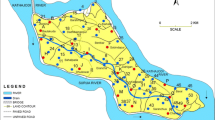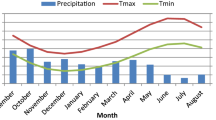Abstract
Forecasting the ground water level fluctuations is an important requirement for planning conjunctive use in any basin. This paper reports a research study that investigates the potential of artificial neural network technique in forecasting the groundwater level fluctuations in an unconfined coastal aquifer in India. The most appropriate set of input variables to the model are selected through a combination of domain knowledge and statistical analysis of the available data series. Several ANN models are developed that forecasts the water level of two observation wells. The results suggest that the model predictions are reasonably accurate as evaluated by various statistical indices. An input sensitivity analysis suggested that exclusion of antecedent values of the water level time series may not help the model to capture the recharge time for the aquifer and may result in poorer performance of the models. In general, the results suggest that the ANN models are able to forecast the water levels up to 4 months in advance reasonably well. Such forecasts may be useful in conjunctive use planning of groundwater and surface water in the coastal areas that help maintain the natural water table gradient to protect seawater intrusion or water logging condition.
Similar content being viewed by others
References
ASCE Task Committee, 2000a, ‘Artificial neural networks in hydrology-I: Preliminary concepts’, Journal of Hydrologic Engineering, ASCE, 5(2), 115–123.
ASCE Task Committee, 2000b, ‘Artificial neural networks in hydrology-II: Hydrologic applications’, Journal of Hydrologic Engineering, ASCE 5(2), 124–137.
Bierkens, M. F. P., 1998, ‘Modeling water table fluctuations by means of a stochastic differential equation’, Water Resources Research 34, 2485–2499.
Campolo, M., Andreussi, P., and Soldati, A., 1999, ‘River flood forecasting with neural network model’, Water Resources Research 35(4), 1191–1197.
Coulibali, P., Anctil, F., and Bobee, B., 2001, ‘Multivariate reservoir inflow forecasting using temporal neural network’, Journal of Hydrologic Engineering 6(5), 367–376.
Coulibaly, P., Anctil, F., and Bobee, B., 2000, ‘Daily reservoir inflow forecasting using artificial neural networks with stopped training approach’, Journal of Hydrology 230, 244–257.
Coulibaly, P., Anctil, F., Aravena, R., and Bobee, B., 2001, ‘Artificial neural network modeling of water table depth fluctuations’, Water Resources Research 37(4), 885–896.
Eberhart, R. C. and Dobbins, R. W., 1990, ‘Neural Network PC Tools: A Practical Guide’, Acedemic Press, New York.
Hornik, K., Stichcombe, M., and White, H., 1989, ‘Multi layer feed forward networks are universal approximators’, Neural Networks 2, 359–366.
Knotters, M. and Bierkens, M. F. P., 2000, ‘Physical basis of time series models for water table depths’, Water Resources Research 36(1), 181–188.
Knotters, M. and Van Walsum, P. E. V., 1997, ‘Estimating fluctuation quantities from the time series of water table depths using models with a stochastic component’, Journal of Hydrology 197, 25–46.
Lebron, L., Schaap, M. G., and Suarez, D. L., 1999, ‘Saturated Hydraulic conductivity prediction from microscopic pore geometry measurements and neural network analysis’, Water Resources Research 35(10), 3149–3158.
Luk, K. C., Ball, J. E., and Sharma, A., 2000, ‘A study of optimal model lag and spatial inputs to artificial neural network for rainfall forecasting’, Journal of Hydrology 227, 56–65.
Maier, H. R. and Dandy, G. C., 1997, ‘Determining inputs for neural network models of multivariate time series’, Microcomputers in Civil Engineering 12, 353–368.
Maier, H. R. and Dandy, G. C., 2000, ‘Neural networks for the prediction and forecasting of water resources variables: A review of modeling issues and application’, Environmental Modeling and Software, 15: 101–124.
Morshed, J. and Kaluarachchi, J. J., 1998, ‘Parameter estimation using artificial neural network and genetic algorithm for free-product migration and recovery’, Water Resources Research 34(5), 1101–1113
Ranjithan, R. S., Eheart, D. E., and Garrett, J. H., 1995, ‘Application of neural network in groundwater remediation under conditions of uncertainty, in New UncertaintyConcepts in Hydrology and Water Resources’, edited by Z. W. Kundzewicz, 133–144, Cambridge University Press, New York.
Rizzo, D. M. and Dougherty, D. E., 1994, ‘Characterization of aquifer properties using artificial neural networks: Neural kriging’, Water Resources Research 30(2), 483–497.
Rumelhart, D. E., Hinton, G. E., and Williams, R. J., 1986, Learning representations by back-propagating errors. Nature 323, 533–536.
Sajikumar, N. and Thandaveswara, B. S., 1999, ‘A non-linear rainfall-runoff model using an artificial neural network’, Journal of Hydrology 216, 32–35.
Schaap, M. G. and Bouten, W., 1996, ‘Modeling water retention curves of sandy soils using neural networks’, Water Resources Research 32(10), 3033–3040.
Silverman, D. and Dracup, J. A., 2000, ‘Artificial neural networks and long-range precipitation in California’, Journal of Applied Meteorology 31(1), 57–66.
Sudheer, K. P., Gosain, A. K., and Ramasastri, K. S., 2002, ‘A data-driven algorithm for constructing artificial neural network rainfall-runoff models’, Hydrological Processes 16, 1325–1330.
Thirumalaiah, K., and Deo, M. C., 2000, ‘Hydrological forecasting using neural networks’, Journal of Hydrologic Engineering 5(2), 180–189.
Van Geer, F. C. and Zuur, A. F., 1997, ‘An extension of Box-Jenkins transfer noise models for spatial interpolation of groundwater head series’, Journal of Hydrology 192, 65–80.
Author information
Authors and Affiliations
Corresponding author
Rights and permissions
About this article
Cite this article
Nayak, P.C., Rao, Y.R.S. & Sudheer, K.P. Groundwater Level Forecasting in a Shallow Aquifer Using Artificial Neural Network Approach. Water Resour Manage 20, 77–90 (2006). https://doi.org/10.1007/s11269-006-4007-z
Received:
Accepted:
Issue Date:
DOI: https://doi.org/10.1007/s11269-006-4007-z




